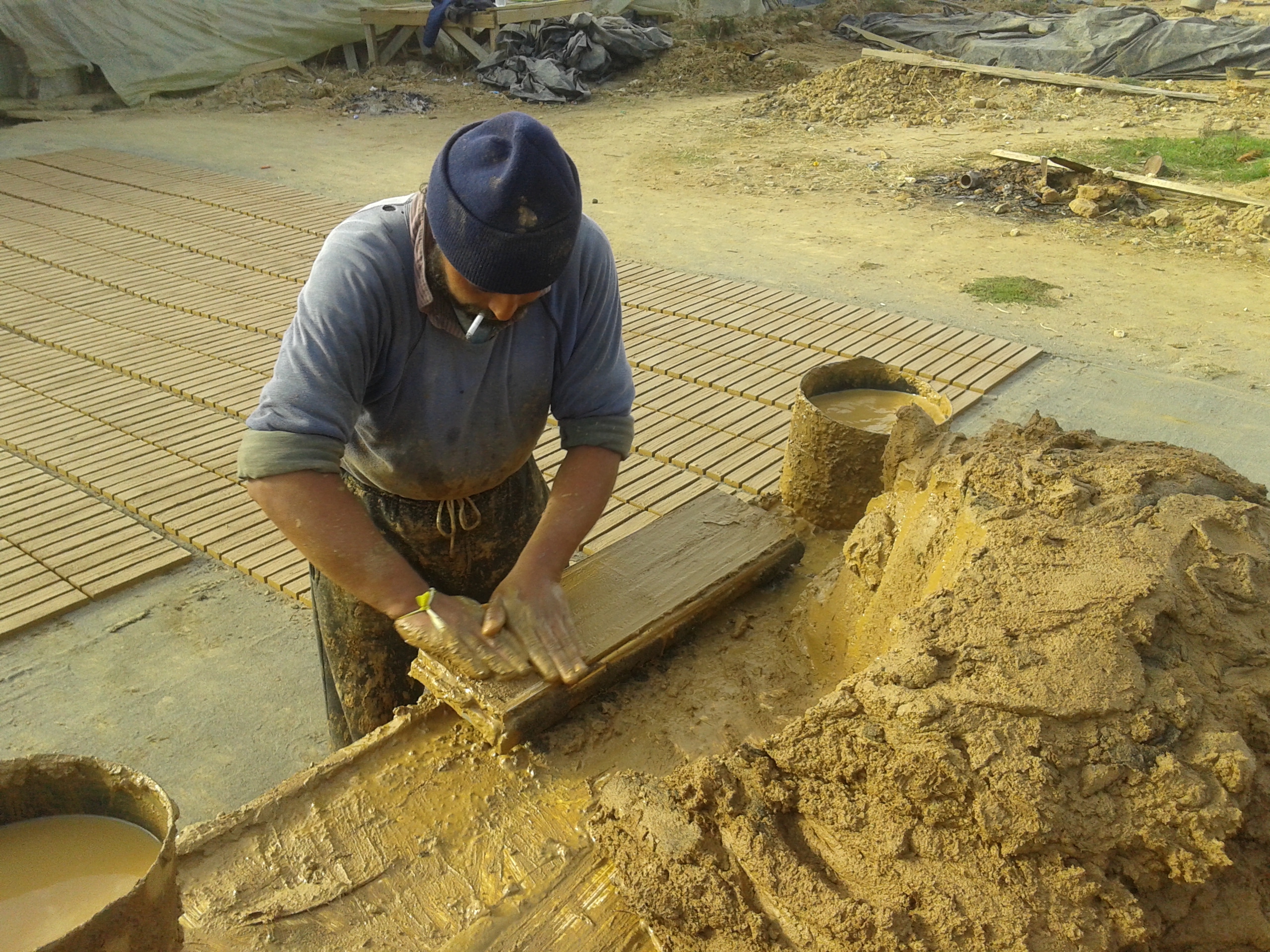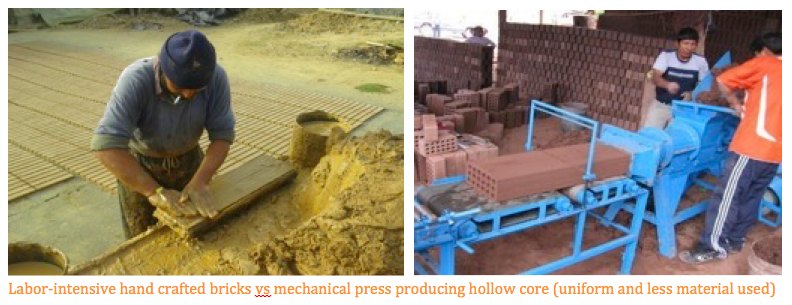Esta entrada también está disponible en: Spanish

Bricks for household and commercial use have been produced for many hundreds, and even thousands of years. The process for producing bricks is rather straight forward and generally involves utilizing clay extracted from nearby land, molding the clay into the desired brick or tile form, drying the raw brick/tile under the sun or in ovens, and then cooking the brick in a makeshift temporary oven built of the same bricks being cooked (clamp or scove design), or in a permanent oven structure, utilizing available wood or other biomass as fuel. In certain cases, waste (including toxic waste such as car tires) is sometimes used as fuel.
Some countries and select groups around the world in places like Southeast Asia, China, and Latin America have taken notice of the contamination derived from traditional brick kilns and are developing technologies to improve the economic efficiency of production (which may in turn have added environmental benefits—such as improving wood burning techniques to lower fuel costs), rarely has the issue been taken up from a public policy perspective.

CHRE currently works with the Climate and Clean Air Coalition (CCAC) of the United National Environmental Program, as coordinator of a Policy Advocacy Network for Clean Brick Production (the PAN LAC) to foster more government engagement and discussion to promote informational exchanges, share knowledge and debate ways forward to reduce deadly and dangerous emissions from brick production, and ultimately to improve public policy to induce sustainable change in the traditional brick production sector to reduce social and environmental negative externalities of traditional brick prodcution.
Created in 2014, and managed by the CHRE, the PAN LAC advocacy network develops and maintains a list of public policy contacts in the traditional brick sector, building on an already growing list of technical experts amassed by the CCAC as well as government contacts taking from CCAC members. The challenge was and continues to be, identifying the potentially interested public officials from ministries (such as Health, Labor, Mining, Production, and others), which are not generally associated to the brick sector and which would need to collaborate in order to develop effective public policies to address the complex and multi-sector dynamics of brick production and its related impacts. This list now includes some 100+ contacts in over 20 countries of Latin America, and is growing.
PAN LAC has also already begun efforts to bring together public officials from the region to launch debates on brick sector strategies and key issues. Some previous capacity building meetings focused on technical aspects of brick production had already been held (for example in Guanajuato México in 2013). The PAN LAC Network held it’s first “official” capacity building course in October of 2014 in Cuzco Peru as a “4th day” side event during a technical workshop on brick production organized by CCAC partner Swiss Contact. It was clear from the first day of the Cuzco 3-day training, that by the end of this technical capacity building workshop, the public officials present wanted and needed to sit down to discuss how they could implement technological transformation trough policy tools. That’s what the PAN LAC is all about.
The Cuzco workshop allowed us to produce a draft training course for policy training, which was piloted in draft form at that time. Following the Cuzco course, CHRE/CEDHA continued developing the draft course and proceeded to deliver a second capacity building course in Maule Chile in April of 2015 and used this experience to finalize a course design. The Maule, Chile capacity building course, like the event held previously in Cuzco, Peru, provided a space for public officials from countries throughout Latin America, to gather to discuss public policy barriers and opportunities to, learn of activities taking place in other parts of the region and to consider ways to address some of the more salient social, economic and environmental problems with traditional brick production.
In sum, the backbone of the PAN LAC Regional Strategy for Latin America which is coordinated by CHRE is to:
-
- Encourage political engagement of CCAC member States on brick policy transformation
- Capitalize and compliment CCAC’s Bricks Initiative with other CCAC initiatives engagement
- Utilize its knowledge and links to experts to provide policy guidance to States
- Help engaged member countries to design inventories and characterize their brick sectors
- Help engaged member countries to identify priorities and possible solutions for the sector
- Help States develop local implementation programs for the traditional brick sector
- Ensure that we transfer knowledge learned in technical components already development
(technical capacity/economic analysis/emissions measurement/regulations) - Help identify and leverage finance for implementation of programs
- Provide technical assistance to implement programs
- Hold further policy awareness workshops to engage States
- Ensure that the CCAC Secretariat and the Lead Partners of the Bricks Initiative properly coordinate and inter-relate future activities of the Bricks Initiative
The goals of the PAN LAC are associated to the areas of work listed above.
In the short and medium term, the PAN LAC must
- Establish itself as a source of information and guidance for evolving policy in the brick sector
- Achieve member State engagement in policy exchange and use of services and products
- Generate actions by engaged States in the development and implementation of policies and plans to address contamination of the traditional brick sector
In the long term, the PAN LAC must
- Result in the establishment and implementation of Traditional Brick Sector Strategies in countries of intervention
- Help catalyze sector changes, including visible steps (such as, but not limited to):
- advancements in measuring and quantifying emissions from the sector
- production of trustworthy sector data on number of kilns, location, emissions, etc.
- innovations carried out in techniques of brick production at participating kilns
- infrastructure investments made to reduce emissions at participating kilns
- measurable reductions in black carbon and other emissions at participating kilns
- reduction of informality of the sector where the CCAC has engaged
- improved working and health conditions for workers and communities
- improvements in economic returns of production where the CCAC has engaged
- improved energy efficiency of kilns where the CCAC has engaged


Publications by PAN LAC
Report on PAN LAC Workshop – Asuncion Paraguay – 2018 [Spanish Only] Part I, Part II
Report on PAN LAC Workshop – Jalisco Mexico – 2017 [Spanish Only]
Report on PAN LAC Workshop – Bogota Colombia – 2016 [Spanish Only]
Report on PAN LAC Workshop – Maule Chile – 2015 [English/Spanish]
PAN LAC Framework Document [English Only]
Compilation of Existing Policy Frameworks [English/Spanish]
Capacity Building Course [English/Spanish]
PAN LAC Regional Strategy [English/Spanish]
Regional Guidelines – 10 Steps for Governments [English/Spanish]
Recommendations and Next Steps for PAN LAC [English/Spanish]
Site Visit Report and Recommendations for Argentina – 2017 [Spanish Only]
Site Visit Report and Recommendations for Uruguay – 2019 [Spanish Only]
Recommendations: National Brick Sector Strategy for Mexico – 2021 [Spanish Only]
